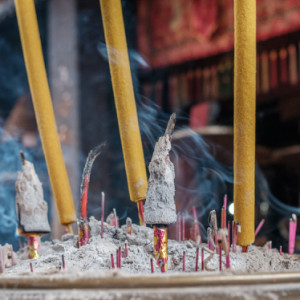A Rainy Trip to Cheung Chau
Fog and rain descended on us today. The tops of the downtown skyscrapers were concealed in cloud. Time for a ferry trip to Cheung Chau, an island south-southwest of Hong Kong Island.
From Mong Kok East, the MTR to Tsim Sha Tsui and a walk along the bridges to the ferry station. I got a wonderful shot of army boats speeding past the waterfront. You can see the cloud creeping down the hill. I loved the way the skyscrapers assumed the pearly green colour of the water in the harbour. It was a 45 minute journey. I fell asleep most of the way.
The island is small. The main street stretches along the western shore and well protected harbour. If I had known the geography, I would have taken the short walk to Tung Wan Beach which is probably more exposed to typhoons. From looking at Google Earth, the buildings seem to be crammed on an isthmus joining the hilly southern and northern ends of the island.
As at Tai O, there are no cars. But we did see tuk-tuks. And masses of bikes, especially parked close to the ferry.
Rain set in. We donned rainwear. I was so glad that Len went to Go Outdoors the morning I left to buy me a rain poncho. It proved invaluable on the trip covering not only me but also my x-t20, which is not weatherproof.
Michael, Julie and I set off in a southerly direction but didn't find much to occupy us, so we retraced our steps and went north. There were signs to the Pak Toi temple and posters and placards advertising the forthcoming Bun Scrambling Competition which is held annually. The festivities centre on the Pak Toi temple. While the others went to look, I rested my weary feet and feasted my hungry belly at the Morocco restaurant. Despite the name, it offers Indian cuisine. I enjoyed a rich chicken curry with rice and a glass of iced tea, under a tarpaulin, while the rain came down.
Julie and Michael returned so I went to look for the temple myself. Large bamboo towers were being constructed on which the buns, now made of plastic, according to Wikipedia, are fixed. On the days of the festival, small teams of climbers ascend the towers removing as many buns as possible. Since an accident in 1978, safety rules have been imposed progressively.
In the shops, you can buy decorated buns made of sesame paste.
The festival honours the god Pak Toi, who protects fisherfolk. Wikipedia also tells me that on three days of the festival, the island people eat vegetarian. Even the many fish restaurants and McDonalds adhere to the principle.
We missed this ceremony by a week. The shops were full of souvenirs and trinkets. It would probably have been very crowded. Still, I bought a bun as a fridge magnet. Watch a YouTube video of the event in 2014.
The Pak Toi temple was charming. People were offering incense and food. It's a strange mixture of the old gods and Buddhism, more Daoist here than at the Monastery of 10000 Buddhas. I lingered to take photos of the exquisite carvings and screens. The extra is of incense sticks burning away, bearing prayers to the gods. Round the back, I found a furnace into which myriads of incense sticks had been tossed. I can only assume that such is the demand for placing incense, the old sticks have to be removed each day. Burning them in the furnace ensures that the smoke still rises to heaven.
It rained virtually all day. The main photo shows three women walking home in rainwear improvised from black plastic bin bags.
I fell asleep on the ferry home.
The group celebrated the end of the trip by going to a Japanese Teppanyaki restaurant in the evening. Choice of food was still limited for me. And there was absolutely nowhere to sit in the rather splendid mall to rest weary limbs.
The Cheung Chai album.


Comments
Sign in or get an account to comment.


